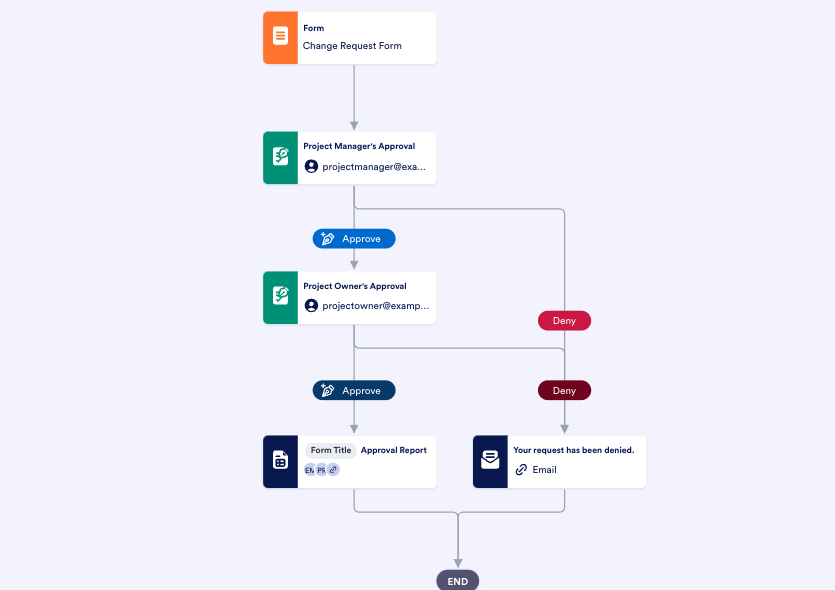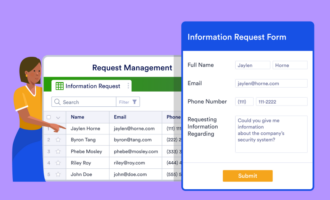Key components of change request process
- Determining if the request is in scope or out of scope
- Gathering data
- Initiating the change request approval workflow
- Communicating approvals
Change is inevitable, especially when you’re running a business.
Whether changes are initiated in-house or through a client, they can fundamentally alter the final product or service. That’s why change request management (the process of keeping track of these alterations) is vital for businesses that want to consistently turn out good work.
To make a change to a project, a client, in-house team, or other stakeholder sends a formal change request to the project management team for analysis, risk assessment, and approval. By automating this process, your team can streamline change requests, minimize their impact on a project timeline, and reduce the burden on project managers.
What is the purpose of a change request?
A change request formally documents changes that need to be made to a project. It also serves as a touchpoint between the person making the request and those who will make the change. Change requests offer project managers the opportunity to determine what effect the change will have on a project and their team. It also helps them with the following.
Minimizing risks
Project managers are responsible for minimizing the impact change requests have on a project’s timeline, resources, and labor. The change request process offers managers the chance to analyze the risks a potential change may have before approving or rejecting it.
Aligning with project goals
Not every request will align with the main goal of a project. When stakeholders submit change requests, project managers must assess the validity of the change before approving it. If a change is too drastic or unnecessary, then they should consider rejecting it.
Minimizing disruptions to ongoing work
Occasionally, the impact of a change request will extend beyond a project’s initial scope. Significant changes will impact the timeline and resources for other projects as well, which is something project managers must take into account prior to approving them.
How does a change request process work?
Although asking for a change to a project may seem relatively straightforward, having a set process in place will make it easier for your team to address, eliminate miscommunication, and keep track of all changes. Following these few steps will keep your project running smoothly and your team from burning out.
Here’s the basic breakdown of the change request process overall.
1. Initiate the change request
Every change request process begins with the submission of the request itself. To ensure your team gets the information they need, use a change request form. When you add an online form to your process, those requesting a change can fill out the necessary information and send it to your project manager for evaluation without having to email it separately.
2. Evaluate and analyze the impact
Once someone has submitted a change request, the project manager will evaluate how the change will impact the project. This includes allocating resources, adjusting timelines, talking with higher-ups, and checking whether a change is within scope or not. These factors will determine the next phase of the change request process.
3. Approve or reject the change request
After the project manager has identified the risks and impact of a change request, they’ll make a decision on whether to accommodate the change. If it’s within the project scope and feasible to complete, the appropriate stakeholders will approve and implement it. If not, they’ll reject it and contact the person or team who submitted the request.
This process safeguards against unwanted changes that could lead to further problems for your team. Implementing these steps helps your team manage these requests effectively.
Key components of change request management
Your process may vary slightly, but these are common components of change request management.
Determining if the request is in scope or out of scope
In-scope changes won’t affect a project’s budget or timeline, and the team can easily execute them. Out-of-scope changes, on the other hand, will alter budgets and, potentially, timelines. Stakeholders must carefully consider how change requests will affect the project and the team’s ability to get work done. Be sure to track the scope of every request.
Gathering data
To make optimal decisions, project managers must provide stakeholders with all the relevant project data on the request’s potential impact. It’s crucial to analyze the consequences of a change to assess whether it’s worth approving.
Initiating the change request approval workflow
As is the case with any process requiring stakeholder approval, it’s vital to officially record a change request. Work with your team to establish what kinds of requests need approvals from higher-ups and who will oversee them. Automating this workflow will also save your team time and money.
Communicating approvals
Once the right stakeholders approve a request, managers need to communicate the changes to the team. Without proper communication, even the best change request management process will be ineffective. This part of the process should also include a follow-up with the client if the request originated from them or if it will impact deliverables.
What should the change request include?
The more thorough a change request is, the easier it is for project managers to process. There are a few key pieces of information required to ensure correct processing of requests.
Title and ID number
Every change request is attached to a specific project. It’s vital that change requests include a project’s title and ID number to easily identify and connect each request to its respective project.
Type of request
Project managers need to understand how a request will impact the project, especially in terms of scope. Each change request should include what type of request it is so the correct stakeholders can handle it effectively.
Source
Project managers need to know who and where change requests come from, so they can inform the requester of a change’s status and ask questions about the request if necessary. A change request should include the requester’s name, department, and relevant contact information.
Description
The details of the change itself are the most important part of a change request. For a project manager to fully understand the extent of a change, the description must be thorough. Vague descriptions lead to unnecessary follow-ups and drawn-out timelines.
What are the types of change requests?
Assigning designations to different types of change requests helps your team react quickly and provides insight into the level of approval needed to go forward. Here are some examples of change request designations:
- Major: These changes significantly impact a project or deliverable, affecting timelines and budgets. Major changes should go all the way to the top of an organization for approval.
- Standard: Most of these changes won’t significantly affect a project, so team leads and managers can handle them. Request standard changes by filling out simple change order forms. Automating approval of these requests prevents them from becoming a burden.
- Emergency: Emergency changes require immediate action. These might only need high-level executive approval, but team leads must monitor their implementation to understand their ramifications.
What are some industry-specific examples of the change request process?
Many industries use change requests, as clients’ needs and expectations may shift over time. In industries like software development, for example, change requests can sometimes fundamentally alter how a product functions.
In these cases, depending on the type of change needed, a single developer will have to change a section of code or an entire team will need to change the structure and design of an application. Project managers must consult with developers and designers to determine how these changes will affect a software’s release — or if the change is even technically feasible.
The question of feasibility is also commonly found in the construction industry’s change request process. If a team is working on a home and a change request comes in for its design, the request could alter the structure of the home.
Sometimes these changes require a total rebuild — costing time, money, and resources. It’s then up to the project manager to work with the client to determine if a change is feasible for their budget and timeline.
What are some of the best change request management tools?
Managing change requests is about more than just having the right strategy. Project managers need the right tools to keep projects on track. Here are some of the most popular change request management tools on the market.
1. Jotform
From change request forms to automated approvals, online form builder Jotform has a solution to match your change request needs. Designed for custom form building, Jotform has a full suite of additional tools to keep your project running smoothly. Store and organize response data with Jotform Tables, edit invoice templates for out-of-scope work through Jotform’s Online PDF Editor, or automate and monitor the approval process through Jotform Approvals.
2. Wrike
An all-in-one project management tool, Wrike is designed to keep project managers on track. Wrike’s interface allows your team to manage change requests with visibility into resource allocation and approvals. Through visual dashboards and Gantt charts, project managers have deeper insight into their team’s ability to perform changes without impacting a project’s scope or timeline.
3. ServiceNow
ServiceNow is a program designed to automate workflows and build interconnectivity among your team members. Its change management product integrates with DevOps and site reliability engineering streamline change processes.
4. Jira
Jira, part of the Atlassian software suite, is an agile project management software known for its integration and adaptability. Jira offers users a “single source of truth” with a visual dashboard to view the progress of your changes and projects. There are also available templates to build workflows in scrum, bug tracking, kanban, and DevOps styles.
Whichever tool you choose, be sure it fits with your current software, project management style, and needs. Adding a tool that’s difficult for your team to learn or that doesn’t match their work style will just create more work for them.
Some final tips on how to automate the change request process
Quickly capturing, logging, and implementing change requests will help your team complete complicated projects. Change logs are also valuable tools for evaluating a project’s workflow after it’s completed.
This is where Jotform is most helpful. Jotform’s fully customizable change request templates and approval forms cover all your change request management needs. Jotform’s table templates, such as this change log template, also help you manage each request as it comes in for approval. Information from your forms will populate your tables, so you’ll see every request in one place.
Jotform Approvals also helps to automate the change request approval workflow. It’s a powerful tool that improves your request processes and helps your team get to work with greater speed and efficiency and less stress.
It also allows you to build your own workflows in minutes with conditional logic. Just drag and drop forms, approvers, and automated notifications to adjust the workflow as needed. You can even get started right away with a change request approval workflow template.
Pro tip
Check out Jotform founder Aytekin Tank’s new book, Automate Your Busywork, to learn how to use no-code automation to streamline processes — like managing change requests — and boost your organization’s efficiency.
Change is necessary. However, with the right processes in place, your team can adapt seamlessly and be able to focus on what’s important. With a solution like Jotform, you and your team can simplify the change request process even further — allowing you to deliver more value.















































































Send Comment: